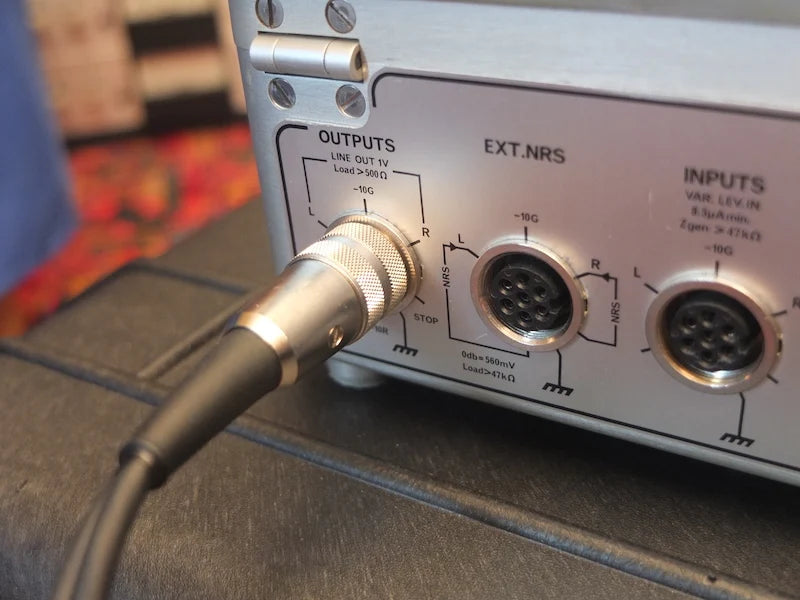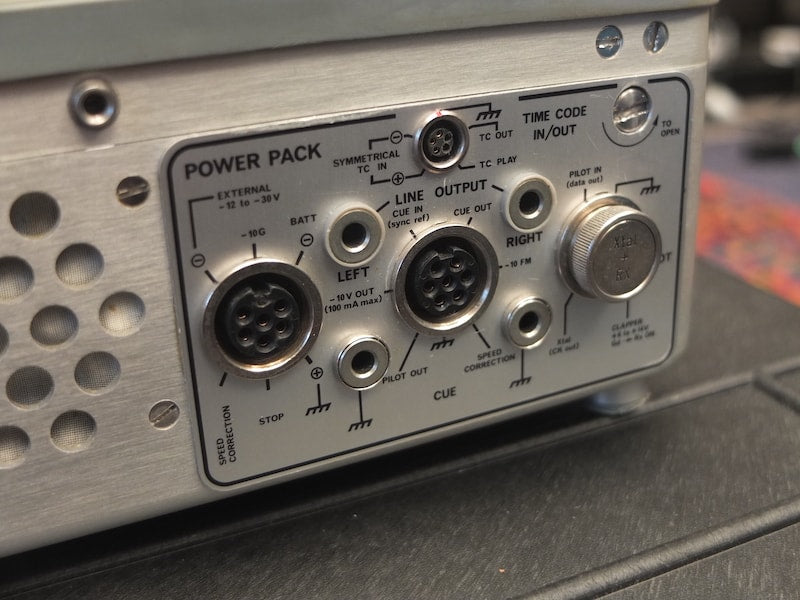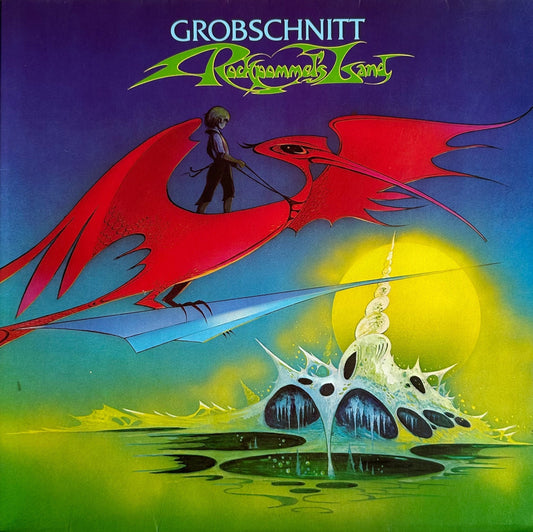Open-reel tape devotees are aware of the current state of support for the format, which is now entirely the province of the niche. As far as machines go – leaving aside ultra-exclusive hardware such as the Ballfinger models – the market consists mainly of pre-owned hardware. For those nervous about buying anything second-hand, there are specialists in the USA and Europe who refurbish machines from TASCAM, Technics, Studer and others to good-as-new or even better-than-new condition. Blank tapes are still available but costly. As for pre-recorded music, the new tapes are expensive, too, in part because of the price of fresh blanks, and are of limited repertoire. I am content with my library of commercial tapes produced from the early 1950s to the mid-1980s.
That leaves everything else that’s tape-related. Obviously, eBay is full of used addenda, such as splicing blocks, but there remains surprising support for reel-to-reel from suppliers of brand-new goods. Clearly targeted more at the professional clientele still using analog tape, they appeal as well to domestic enthusiasts such as I. A quick search via Google yields suppliers of spools, head cleaning kits, rubber pinch roller cleaners, empty library cases, splicing tape, oils, and other useful adjuncts. Other sources will produce custom Perspex/Plexiglas dust covers to order, and I suppose a deeper, more patient search might even uncover new head demagnetizers.
What delighted me no end were the efforts of a hi-fi manufacturer that now joins companies such as Doshi Audio, which produces the Evolution Tape Preamplifier, and other tape-oriented brands sharing that spirit. Doshi’s preamp is not machine-specific; you just need to access the output of a tape deck’s heads in order to bypass the built-in preamp, and it’s easy-peasy to connect to my Denon DH-710F and others of that topology. The product I am about to discuss, however, has its potential sales limited to owners of a specific deck, so kudos, then, to Transparent Audio for delivering a real treat for a finite number of tape buffs.
A fellow enthusiast and Nagra IV-S owner in the UK, an inveterate scourer of the internet for tape-related tidbits, noted some time ago that a dedicated cable had been produced by Transparent Audio for the Nagra IV-S at Nagra’s behest. At first, I scratched my head, wondering what could be squeezed into the 7-pin Tuchel connector used for the deck’s line-out, but I figured, what the heck, I’ll chase down a set. After all, I love the IV-S, which I use to play my treasured first-generation 1/2-track 7.5 ips tapes. It has enabled me to hear the 1950s Broadway performances of My Fair Lady and West Side Story as if recorded last week.

Nagra IV-S tape deck. Courtesy of Adrian Wu.
My friend discovered that Nagra had specified impedance-matched cables for the IV-S which do not use the 7-pin connector, but instead exploit the quartet of 4 mm (or “banana”) sockets on the opposite side of the IV-S. I had never even paid attention to them, as I had always installed my deck with the Tuchel-to-RCA cable for playback.

Tuchel 7-pin output and cable.
Before pestering Transparent Audio with a barrage of questions, I turned to Petronel Butuc of The Audiophile’s Clinic in the UK who services tape decks and knows his Nagras. His first lesson for this novice was to explain the 4 mm sockets’ purpose relative to the more widely-used Tuchel connector. He believes the 4 mm outputs serve two roles, one practical and one electrical.
His first thought was about the possible need for speedy swapping of cables in the field – and it must be stressed that the IV-S is a portable (if heavy) unit definitely designed for mobile usage. There’s no question that the 4 mm plugs can be changed more quickly with simple in/out insertion than unscrewing the Tuchel, replacing the cable with another Tuchel-terminated lead which has to be lined up with the connectors’ notch locators so that no pins are bent, which is then tightened. I tried swapping both types, timed the operation with a freshly-serviced Gallet chronograph, and found that Petronel was right, though it saves only a minute or so. On the other hand, every minute counts for professional users.
As for the second possibility, it’s about the integrity of the connection, which in turn is about the sound quality – and that is surely why Nagra collaborated with Transparent. While the Tuchel 7-pin does provide a locking collar, it makes the signal contacts for the left and right channels’ output through seven tiny pins, whereas the Transparent-made alternative provides far greater surface contact area with four 4 mm plugs.

The Transparent Cable with 4 mm connectors, in situ.
OK, so they aren’t screwed in like the Tuchel, but I suspect most Nagra IV-S owners who are likely to purchase the dedicated cables – i.e., audiophiles – are not using them in the field to record soundtrack dialog for films on location, or to interview soldiers under fire. The mechanical security of the connection therefore is moot.
Next, Petronel provided the technical specifications from the Nagra literature, which – as you will see – would affect any comparisons’ validity, swiftly noted by those of you who are moved more by numbers than subjective sound. So, before getting to the performance, please note the following electronic differences between the Tuchel 7-pin output, and the four 4 mm sockets:
According to the Nagra schematics, the LINE OUTPUT CONNECTORS (7-pin Tuchel connector) possess the following configuration:
Pin 1 = Channel 2 (Right) output voltage 1V at 0 dB, minimum impedance 500 ohms
Pin 3 = Channel 1 (Left) output voltage 1V at 0 dB, minimum impedance 500 ohms
Pin 7 = Ground
This is in parallel with the 4 mm sockets, which are specified as:
LINE OUTPUT RIGHT: Channel 2 (Right) line output on banana jack, 1V at 0 dB, impedance load 5k ohms
LINE OUTPUT LEFT: Channel 1 (Left) line output on banana jack, 1V at 0 dB, impedance load 5k ohms
Petronel also notes that for the 4 mm (banana) outputs, a 1.5nF capacitor is fitted between the hot (signal) and ground. What these differences would reveal about the sound in measurable terms is difficult to qualify for a number of reasons, which will explain clearly why my findings in this report are strictly subjective. And yes, I realize that there are savvy measurements guys among you who know how, say, 500 ohms vs 5k ohms will affect the sound.

Tuchel 7-pin (left) and Transparent Cable with 4 mm termination (right).
Thus, allow me to state emphatically that we are not comparing like-with-like here. The ultimate conclusions and observations are strictly subjective, aside from the aforementioned practical concerns about easy connectivity versus a locking mechanism. Please take note of this: I do not want a barrage of “what-about”s from anyone who wants to point out the obvious – that they are bound to sound different. Our only interest here is: Do the 4 mm outputs with the Transparent cables sound better than the 7-pin output? So, to preempt the trolling, among the variables with which we must contend are the following:
Relative output levels: I dealt with this by using a test signal and matching the levels, as A/B’ing the two types of outputs is possible with the preamp I use thanks to its option for adjusting input levels. Thus I was able to switch from 7-pin to 4 mm from the hot seat via the remote, completely factoring playback levels out of the equation.
Cable types, lengths, and differing RCA plugs: My Tuchel 7-pin cable may be a modern replacement or update rather than an original as supplied with the Nagra IV-S from new. It consists of 5.5 feet of Sommer Peacock Mk II AES/EBU OFC with spring-loaded, gold-plated Neutrik RCA phono plugs. The Transparent cable comprises a 6-foot pair of Reference interconnects with the company’s top-grade RCA plugs, also gold-plated. Transparent separates the source end into robust 4 mm plugs with a nice, tight friction fit.
Before entering into the listening regimen, I contacted Transparent Audio’s Karen Sumner for some background information on the project, especially regarding the choice of the assuredly high-end Reference level interconnect, as Transparent has a number of ranges above and below. A pair or Reference interconnects terminated in RCA phono plugs at both ends retails from $3,400, while the Nagra IV-S-specific version adds a charge for converting it to 4 mm bananas at the tape deck end.
Karen told Copper, “The Nagra IV-S Reference Transparent Cables were the result of a collaboration between Nagra and Transparent. We decided at the time that Reference was the optimum performance level and price point. In addition to the special termination on the source end, the cable is calibrated for the Nagra.
“Reference is the first product in our lineup that is calibrated to its source. The special termination requires quite a lot of extra labor and comes with a $200 upcharge from the regular suggested retail for Reference RCA cable. We, of course, would provide the special termination on Ultra, Super, or Plus RCA cables for Nagra IV-S owners. But I am not sure the termination upcharge is justifiable for cables that are less expensive than Plus. Also, a product of the performance level of the Nagra IV-S should have higher performance cables hooked up to it than MusicLink.”
This candid reply was to-the-point: I have compared numerous levels of Transparent cables over the years, and the sonic hierarchy is clearly audible – even moving from the two least expensive lines – so I have no doubt Reference was selected for discernible performance gains and matching. Crucially, though, a Nagra IV-S in top condition will now set you back $5,000 – $6,000 and I have seen mint examples sell for double that, so Karen’s observations about price and value are consistent with what she has maintained over the decades.
But forget about the cost for a moment: when you have a source component as close to perfect as the Nagra IV-S open-reel tape deck, why would you compromise on the cables?
Next time: the sound…
For more information on the Transparent Nagra cable, please contact Transparent Audio at support@transparentcable.com, or:
Transparent Cable
47 Industrial Park Road
Saco, ME 04072
207-284-1100
Images courtesy of the author except where noted.



